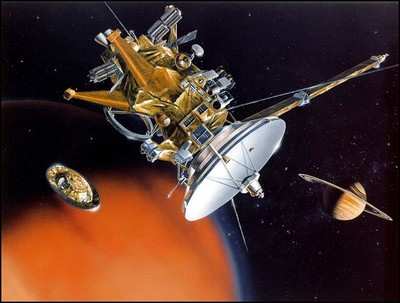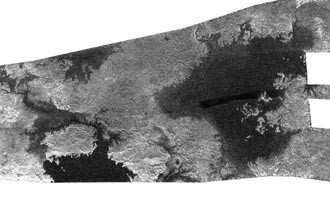Large Seas Likely Filled With Liquid Methane
If you don't believe the Cassini spacecraft has lived up to its
promise of studying Saturn and its moons more closely than any
other probe before it, NASA has some lakefront property on Titan to
sell you. Literally.

NASA tells ANN instruments on Cassini recently uncovered
evidence for seas, likely filled with liquid methane or ethane, in
the high northern latitudes of Saturn's moon Titan. One such
feature is larger than any of the Great Lakes of North America, and
is about the same size as several seas on Earth. (The image above
shows a comparison between one of the suspected Titan lakes, and
Lake Superior.)
Cassini's radar instrument imaged several very dark features
near Titan's north pole. Much larger than similar features seen
before on Titan, the largest dark feature measures at least 100,000
square kilometers (39,000 square miles). Since the radar caught
only a portion of each of these features, only their minimum size
is known.
Titan is the second largest moon in the solar system and is
about 50 percent larger than Earth's moon. The Cassini-Huygens
mission is a cooperative project of NASA, the European Space Agency
and the Italian Space Agency.

"We've long hypothesized about oceans on Titan and now with
multiple instruments we have a first indication of seas that dwarf
the lakes seen previously," said Dr. Jonathan Lunine, Cassini
interdisciplinary scientist at the University of Arizona,
Tucson.
While there is no definitive proof yet that these seas contain
liquid, their shape, their dark appearance in radar that indicates
smoothness, and other that properties point to the presence of
liquids. The liquids are probably a combination of methane and
ethane, given the conditions on Titan and the abundance of methane
and ethane gases and clouds in Titan's atmosphere.
Cassini's visual and infrared mapping spectrometer also captured
a view of the region, and the team is working to determine the
composition of the material contained within these features to test
the hypothesis that they are liquid-filled.
The imaging cameras, which provide a global view of Titan, have
imaged a much larger, irregular dark feature. The northern end of
their image corresponds to one of the radar-imaged seas. The dark
area stretches for more than 1,000 kilometers (620 miles) in the
image, down to 55 degrees north latitude. If the entire dark area
is liquid-filled, it would be only slightly smaller than Earth's
Caspian Sea. The radar data show details at the northern end of the
dark feature similar to those seen in earlier radar observations of
much smaller, liquid-filled lakes. However, to determine if the
entire dark feature is a liquid-filled basin will require
investigation through additional radar flyovers later in the
mission.
The presence of these seas reinforces current thinking that
Titan's surface must be re-supplying methane to its atmosphere, the
original motivation almost a quarter century ago for the
theoretical speculation of a global ocean on Titan.

Cassini's instruments are peeling back the haze that shrouds
Titan, showing high northern latitudes dotted with seas hundreds of
miles across, and hundreds of smaller lakes that vary from several
to tens of miles.
Due to the new discoveries, team members are re-pointing
Cassini's radar instrument during a May flyby so it can pass
directly over the dark areas imaged by the cameras.
(Images courtesy of NASA and JPL)
 ANN's Daily Aero-Term (05.01.24): Say Altitude
ANN's Daily Aero-Term (05.01.24): Say Altitude ANN's Daily Aero-Linx (05.01.24)
ANN's Daily Aero-Linx (05.01.24) Classic Aero-TV: Korean War Hero Twice Reborn
Classic Aero-TV: Korean War Hero Twice Reborn Airborne 04.29.24: EAA B-25 Rides, Textron 2024, G700 Deliveries
Airborne 04.29.24: EAA B-25 Rides, Textron 2024, G700 Deliveries Airborne Affordable Flyers 05.02.24: Bobby Bailey, SPRG Report Cards, Skydive!
Airborne Affordable Flyers 05.02.24: Bobby Bailey, SPRG Report Cards, Skydive!





